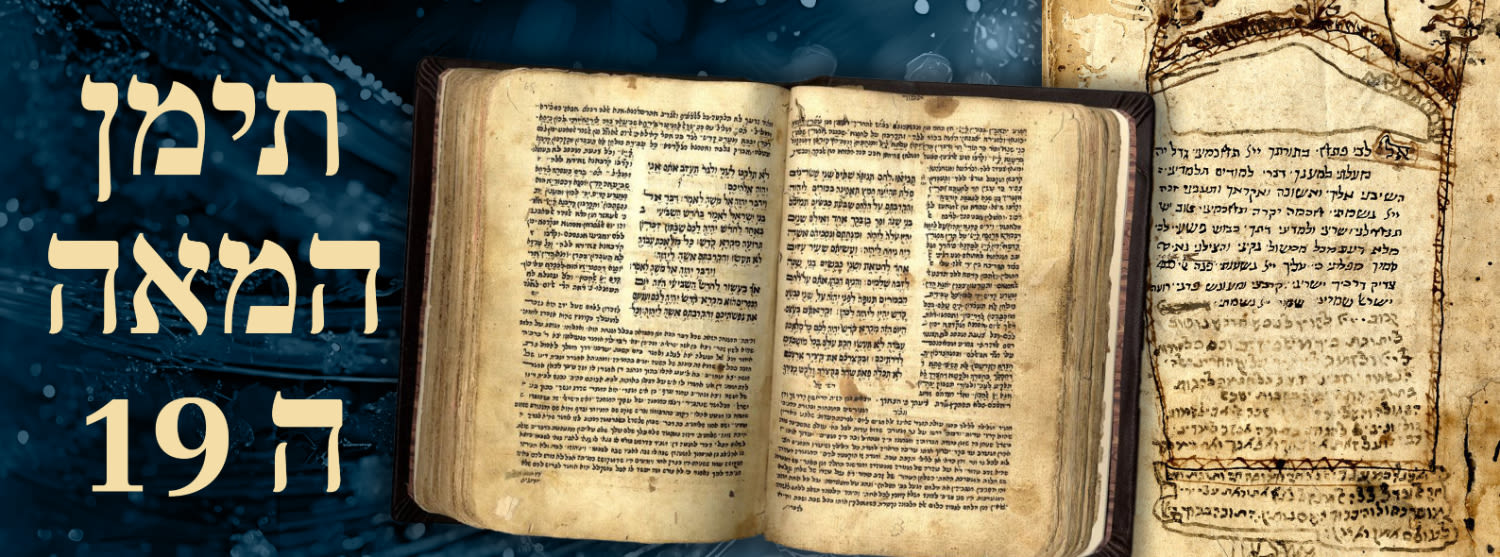
Manuscript, Chumash Vayikra-Bamidbar, with Aramaic translation and Rash”i’s commentary. [Yemen, c. 19th century]. Biblical text with cantillation and lower vowelization, Targum Onkelos with upper vowelization.
Rash”i’s commentary is written at the bottom of the leaf and completed later on separate leaves. The manuscript concludes with an ibur chart. [119] leaf, thick paper. 24 cm.
Moderate condition. Worming perforations. Aging stains. Slight tears. One detached leaf. Magnificent new leather binding.
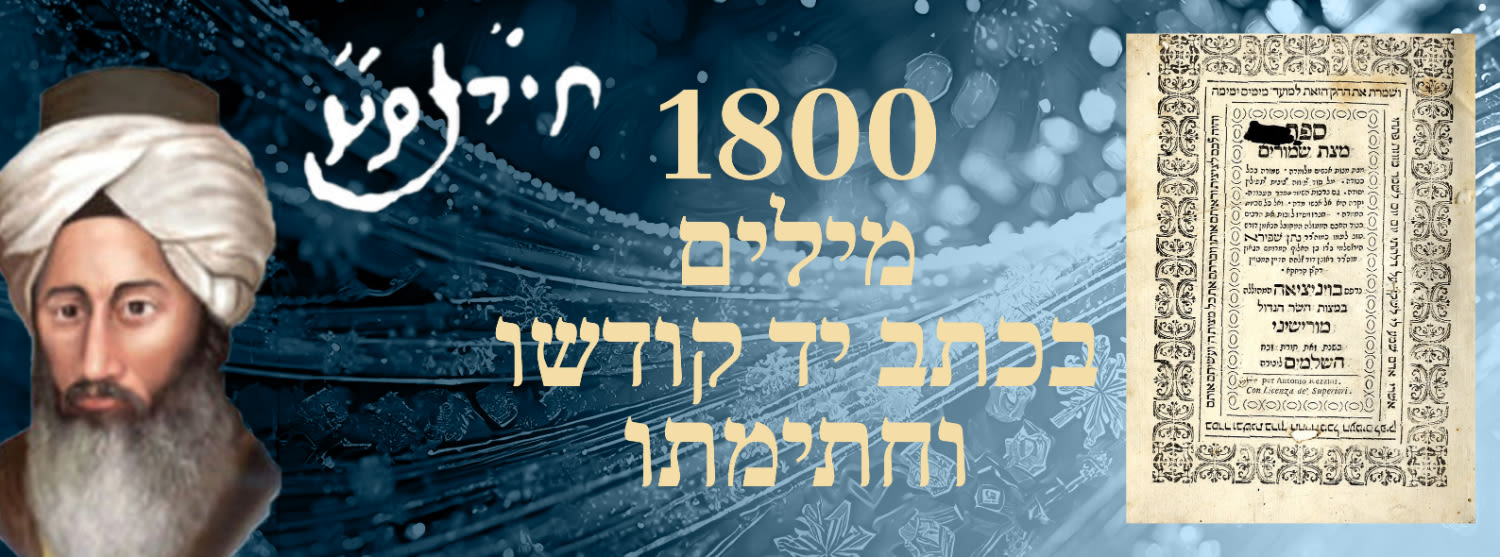
“There is a great tzaddik in Italy [the Chid”a] whose works neutralize all the books of heresy” (The Noam Elimelech of Lizhensk)
Sefer Matzot Shmurim is a Kabbalistic elucidation according to the Ar”i’s approach, to mezuzah, tzitzit and tefillin (מצ”ת) and more, by the G-dly Kabbalist Rabbi Nattan Shapira. Venice, 1660. First edition. Personal copy that belonged to the light of the world, the Chid”a.
Rabbeinu Chaim Yosef David Azoulay’s signature appears on the title page: ‘Chid”a, S”T.’ Two leaves are bound at the end of the sefer [4 written pages – approximately 1800 words!] handwritten by the Chid”a, with the critiques of the G-dly Kabbalist Rabbi Moshe Zakut on the sefer . These glosses were not printed in the Ramaz’s sefarim (printed only recently, see below.) The Chid”a apparently copied the glosses from the Rama”z’s manuscript.
These critiques are extremely important, in the depth of Kabbalistic doctrine and including sacred Names and the most lofty Kabbalistic concepts, some in sharp language, in the Torah way. In one comment, the Rama”z writes, “[It appears to me, Rabbi Moshe Zakut] there are several mistakes here …” and in another comment: “Understand all that is written here and find in each one from among two of the rabbi’s ways … all of the author’s difficulties have merit. He also revealed a new secret in the mezuzah unimagined by the Rishonim or Acharonim .”
This is unparalleled rare and important early evidence to the fundamental dispute on these topics of two “heavenly angels” – the Ashkenazic Kabbalist Rabbi Nattan Shapira – ‘HaRav Nas”i’ [ה’רב נ’תן ש’פירא י’שמרהו א’להים] as the Chid”a refers to him, of Kraków and Jerusalem, and the Sephardic Kabbalist Rabbi Moshe ben Mordechai Zakut [known as the Rama”z], one of Italy’s leading Kabbalists. We will again emphasize that these glosses were not printed in the Rama”z’s sefarim . This is probably the earliest source (or at least one of the earliest sources) for the Rama”z’s glosses on Matzot Shmurim !
The two Kabbalists – Rabbi Moshe Zakut and Rabbi Nattan Shapira – both considered gedolei hador – held each other is very high regard alongside their sharp disagreement understanding the methods of Kabbalah. In his approbation to the sefer Tuv HaAretz (Venice, 1655), the Rama”z writes: “This sefer was written by a rabbi who lights up the Earth and its inhabitants, full as a pomegranate … expert in the mysteries of the world, who understands secrets, the virtuous and faithful Kabbalist, friend and brother to me, the lofty sage Rabbi Nattan Shapira of Jerusalem …” On the other hand, in one of his letters, he writes, “I will inform you that most of the intentions for the morning blessings from Sefer Matzat Shmurim are Rabbi Nattan Shapira’s own. Do not follow them, because we do not have the authority to innovate intentions, even if they are based on faithful precedent …”
The Chid”a himself quotes the author of Matzot Shmurim several times in his own sefarim – Chaim Sha’al , L’David Emet , Machzik Brachah , Dvash L’Fi and more. He also wrote about him in Shem HaGedolim.
Refer to the Hebrew catalog text for brief biographies of the G-dly Kabbalist Rabbi Nattan ben Reuven David (Tevele) Shapira and the owner of the sefer , Rabbi Chaim Yosef David Azoulay .
The Rama”z’s critiques on this sefer can be found in several manuscripts, but were unpublished until recently. These glosses were printed in Kovetz Tzfunot 17 (Bnei Brak, 1993), pp 23-27.
[1], 4-8, [4], 9-12, 21-84 leaf, + [1] handwritten leaf at the beginning of the sefer and [2] leaves handwritten by the Chid”a at the end of the sefer . Lacking leaves 2-3 (the content of leaf 3 is also completed by hand). Approximately 18.5 cm.
Fine condition. Isolated worming perforations and tunnels. Grease stain at the top of the leaves of the sefer . Two perforations and an erasure in the title page. Antique binding (possibly the original), slightly blemished.
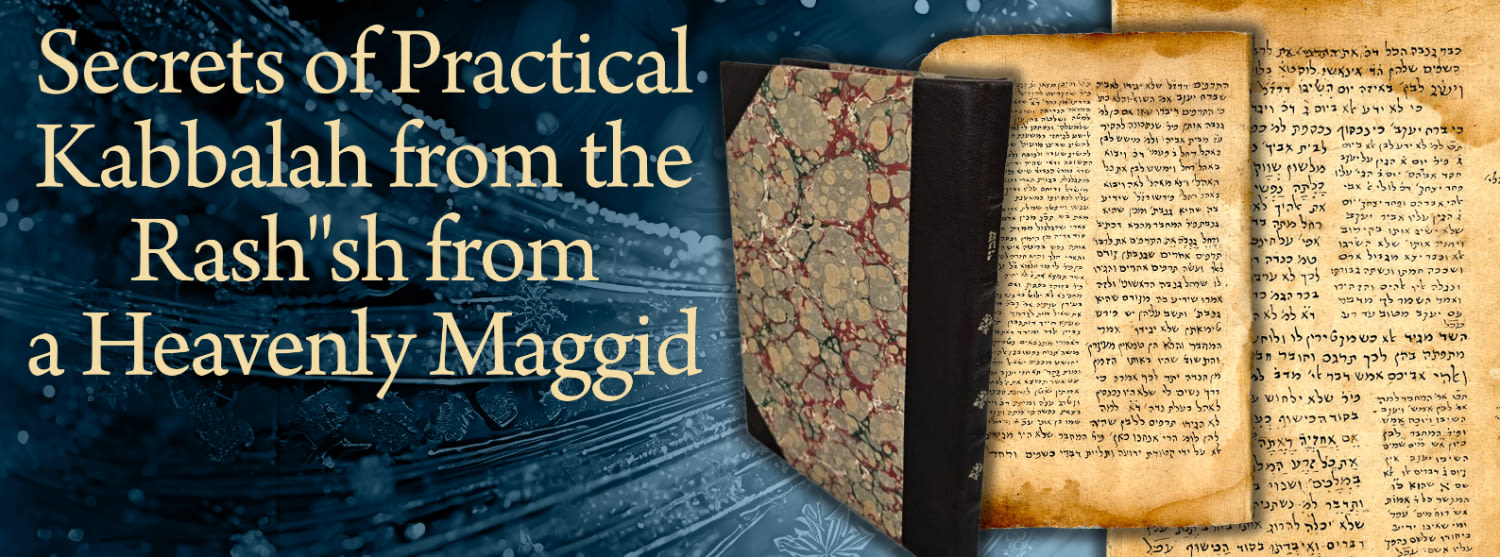
“As explained to me by Mar Chalma …”
Very beautiful manuscript discussing deep issues in practical Kabbalah and superseding natural conduct through mystical powers. Two pages written beautifully and exceptionally clearly, perfectly typeset, handwritten by the G-dly Kabbalist Rabbi Shalom Shabazi, leading poet and Kabbalist of Yemen in his generation. Tradition relates that he would undergo kefitzat haderech every Friday from Yemen to the Land of Israel. This manuscript is from the first edition of his never-printed sefer , Chemdat Yamim . Yemen, c. 1640.
This manuscript discusses parashat VaYetze, the symbolic meeting between Lavan and Ya’akov after the latter fled, when Lavan, according to the Rasha”sh here, unsuccessfully attempted to damage Ya’akov Avinu, the imahot and the shevatim , through sorcery. The sacred Rasha”sh expounds in this rare manuscript upon the spiritual powers in the world, both sacred and via sorcery, through which one can overcome nature – how they work, and how they can be superseded.
We will point out that this manuscript was prepared for print, including the tosefet ta’am at the sides of the pages, yet it still contains many differences from the final printed sefer . This is therefore likely a leaf from the mahadura kamma of the sefer Chemdat Yamim . He completed the sefer in 1646, but it was not printed, and was only known about through tradition! (The text that was eventually printed is from the mahadura batra of the manuscript, written by the Rasha”sh years later. Refer to Kovetz Ma’amarim published upon the Rasha”sh’s 350th birthday, published by the Va’ad HaKlali L’Kehillat HaTeimanim, Jerusalem, 1972, p. 10.)
Aside from the unique content of the manuscript, which discusses practical aspects of Kabbalah and detecting sorcery, and how they can be harnessed for use by people, the manuscript also contains a chiddush the Rasha”sh heard from a maggid – a Heavenly angel who appeared to select gedolei Yisrael [the most famous of whom was the author of Shulchan Aruch]. The Rasha”sh refers to the maggid as “Mar Chalma.” “Mar Chalma” is cited by the Rasha”sh in all his sefarim at total of only thirteen times. This is one of those thirteen wondrous mentions of the Heavenly maggid , handwritten by the Rasha”sh himself!!
Manuscripts by gedolei Yisrael from all circles are known to have been used across the Diaspora as tried-and-true amulets for protection and success. This is therefore a powerful amulet handwritten by one of the two giants who emerged from the Yemenite exile from the day they were expelled from the Holy Land (both of which, astonishingly, were known by the same abbreviation, Rasha”sh). It contains Kabbalistic sacred Names, which grant mystical powers to amulets, like the soul in a body. Refer to the Hebrew catalog text for five examples in the text.
Refer to the Hebrew catalog text for a brief biography of the G-dly Kabbalist, Rabbeinu Shalom Shabazi – the Rasha”sh , and a short discussion about the maggid , Mar Chalma .
[2] pp, approximately 21.5×14.5 cm. Thick, high-quality paper.
Very fine condition. Aging stains. Magnificent new leather binding, as befits this sacred writing.
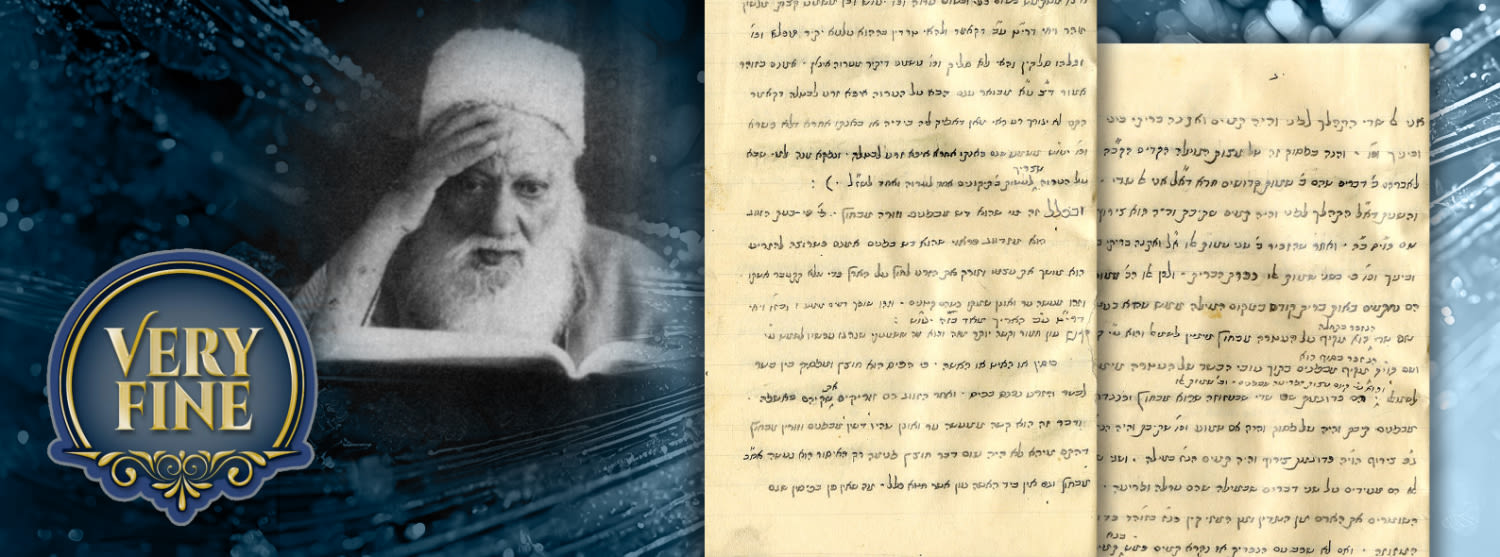
“I would ask each and every one of our Jewish brethren studying Saba D’Mishpatim, upon completing their studies, to study this drush each and every time, because it is not without merit” (from Rabbi Yehudah Ptayah’s introduction at the beginning of this kuntress )
Complete Kabbalistic drush , entirely [21 pp] handwritten by the leading Kabbalist of recent generations, the G-dly Kabbalist Rabbi Yehudah Ptayah, who shook the world with his sefarim and his wonders. [Jerusalem, pre-1939]. Printed in Sefer Saba D’Mishpatim (Jerusalem, 1939), in the drushim section.
Saba D’Mishpatim is one of the famous three passages in the Zohar HaKadosh [alongside the Adarot ]. It was written during parashat Mishpatim [hence its title] when the ‘Saba’ [-a Heavenly being] came to the Tana’im and revealed to them, through riddles he asked them, secrets of Creation and reincarnation. Many commentaries have been written by Kabbalists on Saba D’Mishpatim . Kabbalist Rabbi Yehudah Ptayah also wrote his own commentary to Saba D’Mishpatim (Jerusalem, 1939; refer to the photocopy) after which he wrote this drush here, which, according to what Rabbi Ptayah himself writes at the beginning of the kuntress , is worthwhile to study each time one completes reading Saba D’Mishpatim .
This is the entire drush , from the preface at the beginning to the short colophon at the end of the drush : “Rabbi Chanina etc. Drush 1 is complete; following is Drush 2, written with the first drush to judge the Jewish people in the Diaspora favorably.” Indeed, after the end of the drush , Rabbi Ptayah begins a different drush which spans two leaves and ends in the middle of the last page but does not continue [the sefer does print the continuation].
The segulah of Sefer HaZohar is known to be in the act of reading it, especially reading the Adarot and Saba D’Mishpatim which are the important parts of the Zohar , as revealed by the Ar”i and his close disciples. This is a complete drush composed by the Kabbalist of recent generations on Saba D’Mishpatim . At the beginning, Rabbi Ptayah himself hints at its importance and segulah: “It is not without merit”!! Manuscripts by tzaddikim of the generations are known to be used as amulets. How much more so this sacred writing by the leading Kabbalist, on the deepest Kabbalistic concepts with blessings and sacred Names along its entire length, in his own hand.
21 leaf, 21×12 cm, entirely in Rabbi Ptayah’s penmanship. in pencil . His sacred and clear fingerprints appear along the kuntress , as ink leaked from the quill.
Very fine condition.
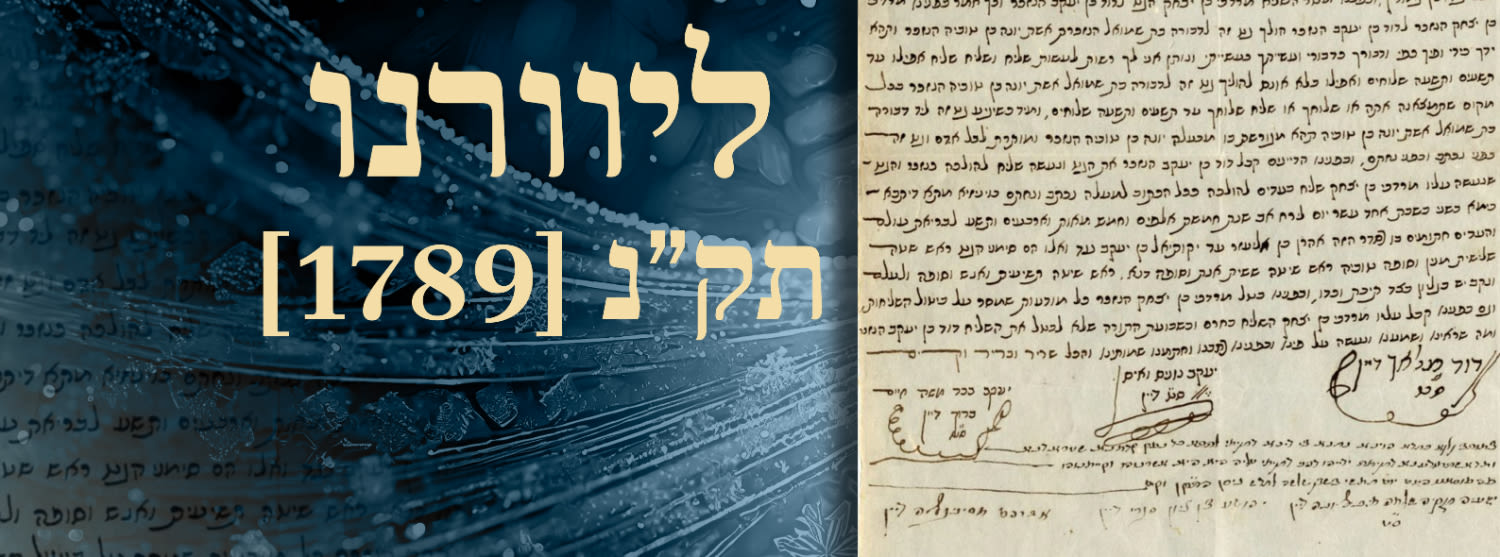
Important, beautiful and lengthy halachic document [over 400 words]. Letter permitting appointing a messenger to deliver a get , signed by leading 18th-century Italian rabbis. Livorno, 13 Kislev, 1789.
Ma’aseh beit din carried out by leading Italian sages of their generation, a rare shaliach oseh shaliach contract – a messenger to deliver a get appointed by the Venice beit din appointing an additional messenger at the Livorno beit din to deliver the get to the wife and transfer it at the beit din in Torino.
Dayanim who signed on the shtar are as follows:
The gaon and Kabbalist Rabbi Ya’akov Nunes-Vais, av beit din of Livorno, the Chid”a’s successor and one of his primary disciples. The letter is apparently all in his penmanship.
His teacher, Rabbi David Malach, one of Livorno’s scholars and rabbis, close associate of the Chid”a and of the Zera Emet.
The gaon Rabbi Ya’akov b”r Moshe Baruch, a dayan in Livorno and author of the renowned work Shivchei Yerushalayim (Livorno, 1785).
Signatures from Torino dayanim appear in the margins, confirming delivery of the get :
The gaon Rabbi Yeshayah Chizkiyah Shlomo Michael Yonah, av beit din of Torino, one of the leading geonim of Italy and close friend of the Chid”a’s. The entire series of lines of the kiyum are apparently in his hand.
The gaon Rabbi Yehoshua Ben Tziyon Segri, av beit din of Casali. [A letter from him appears in this catalog.]
The gaon Rabbi Avraham of Senigallia, a sage and dayan in Florence.
Refer to the Hebrew catalog text for brief biographies of all the above signatories.
[1] double leaf, 19.5×25.5 cm each. High-quality greenish paper. Judeo-Italian script.
Very fine condition.
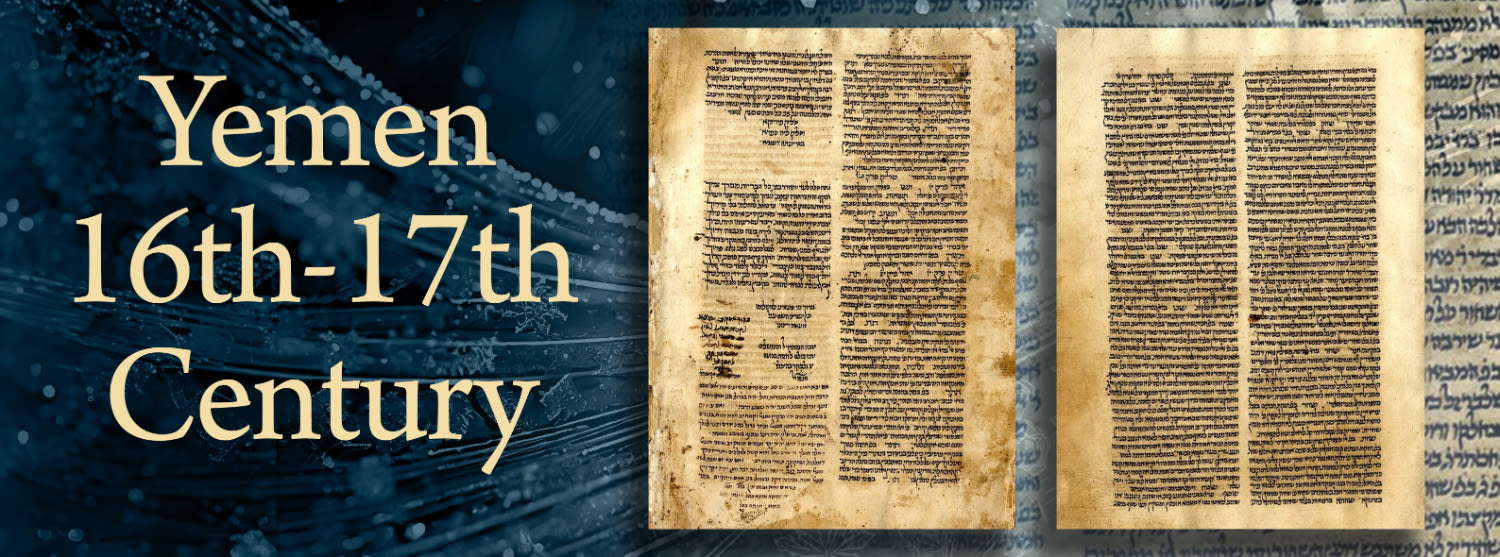
Manuscript. Compilation from Sefer HeAruch , the famed and fundamental Talmudic dictionary by Rabbeinu Nattan MiRomi – beautiful and orderly Yemenite script. C. late 16th – early 17th century.
The manuscript begins with the letter פ’, entry פלט, and continues to the end of the letter ת’.
The many textual differences and omissions in this manuscript give the impression that it intentionally underwent some editing.
It also includes internal divisions into chapters within the section for each letter which do not appear in the printed sefarim , and are apparently unknown from other sources, such as in the letter פ’ – entries that begin with פ”ס start a new chapter, as do those that start with פ”ע and פ”צ and so on.
Written two columns to a page. The names of the entries appear in large letters, more block-like.
Rhyming colophon at the end (with the original date the sefer was written by the author of the Aruch , and dates from Creation, the destruction (of the Beit HaMikdash ) and of shtarot ).
Crossed-out owner’s signature at the end: I, Avraham Ben-Oded (the Ben-Oded family was a renowned Yemenite family of scholars and scribes.)
[78] pp. 21×28 cm.
This manuscript has not yet been sufficiently examined and must undergo a deep examination to determine its quality and uniqueness.
Fine condition. Few stains. Few worming perforations. Not bound.
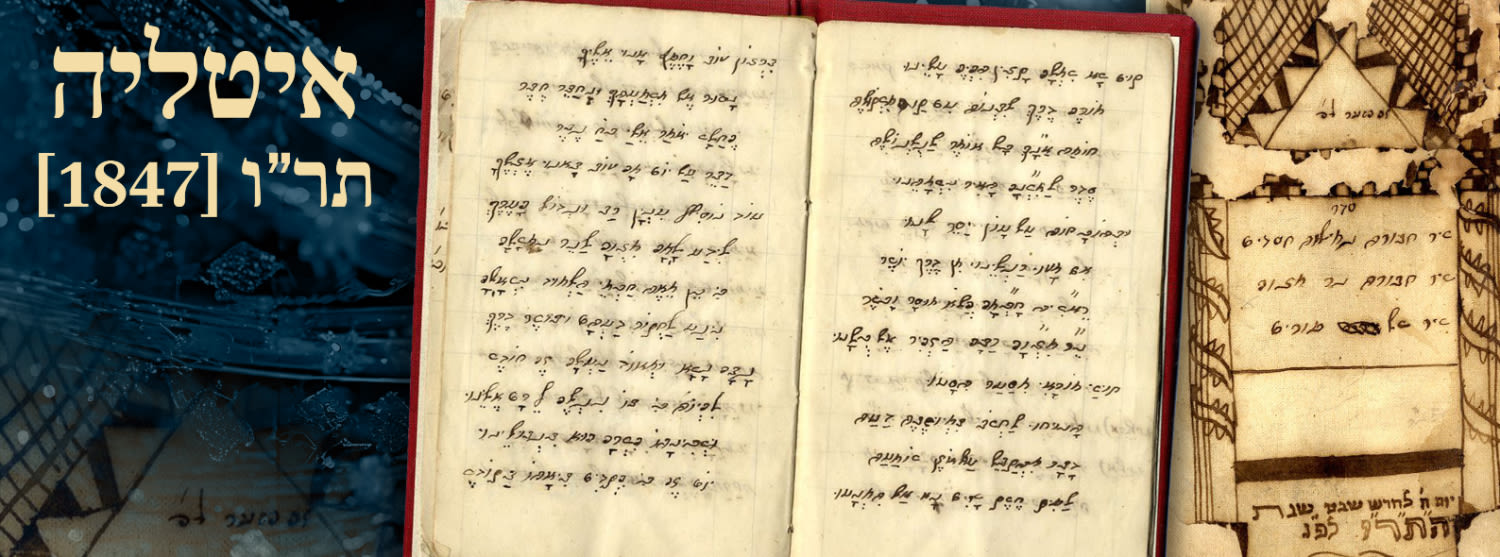
Ledger with songs and hymns sung in various chevrehs and communities in Italy. The manuscript opens with a general title page with a beautiful decorative border. Additional dedicated title page for each song. Italy, 1847
Manuscript content:
Pp.[1-3]: two title pages
Pp. [4-9]: song of Chevrat Gemilut Chassadim
Pp. [11-20]: song of Chavurat Ner Mitzvah
Pp. [21-29]: song in honor of a miracle that took place in one of the Italian communities. The second of Adar was established there as a Purim day to commemorate the miracle. Noted at the beginning of the song is that it was composed by Rabbi Ya’akov b”r Yitzchak of Recanati in Acqui, 1786/תקמ”ו [chronogram: אתה תקו”ם תרחם ציון].
[1] bound ledger, 9×14 cm. [30] pp. Judeo-Italian script. All the songs are vowelized.
Fine condition. The title page is blemished and restored. New red fabric binding.
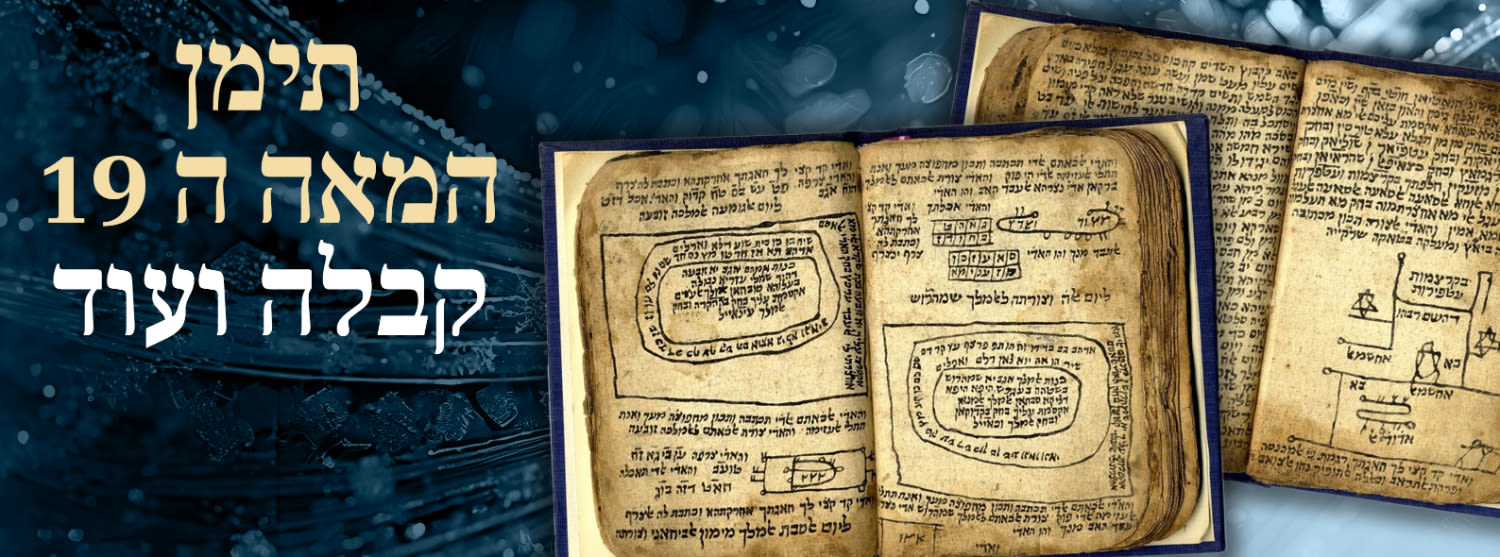
Beautiful manuscript in Yemenite script (the final ten leaves are bound from a different manuscript). Judeo-Arabic and Hebrew. Many sketches and illustrations, and ktav mal’achim .
[89] leaf. 16 cm.
Moderate condition. Tears and wear. Stains, including damp stains. Worming marks, with damage to the text.
Simple new binding.
Provenance: Gross Family Collection, Tel Aviv, YM.011.040.
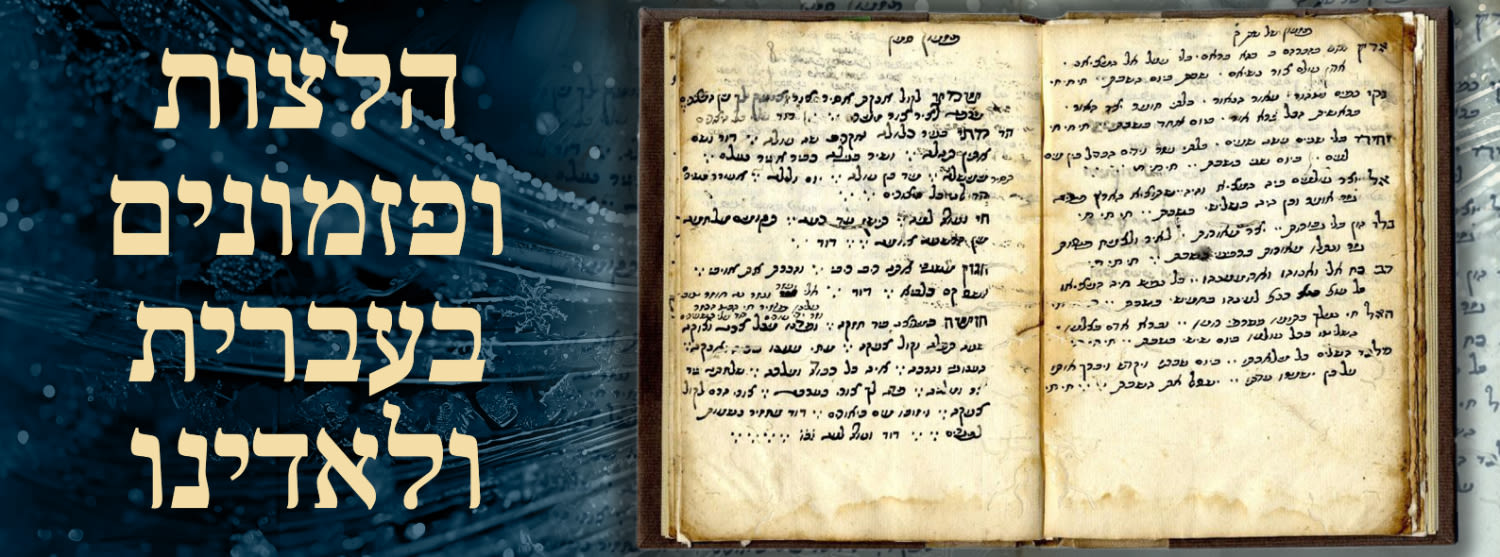
Manuscript with samples of poetic phrases for letters ( halatzot ) in Hebrew and in Ladino, and rhymes. Unknown author. Turkey, 19th century.
The halatzot are poetic phrases written in rhyme, composed as a resource to help people who want to write missives beginning with poetic salutations in rhyme, as was the way of Sephardic chachamim . The two last leaves contain halatzot in Ladino .
[30] pp, 14×19 cm. Thick, high-quality paper.
Moderate-fine condition. Damp stains. Worming tunnels. Minimal tears with paper reinforcements. New binding.
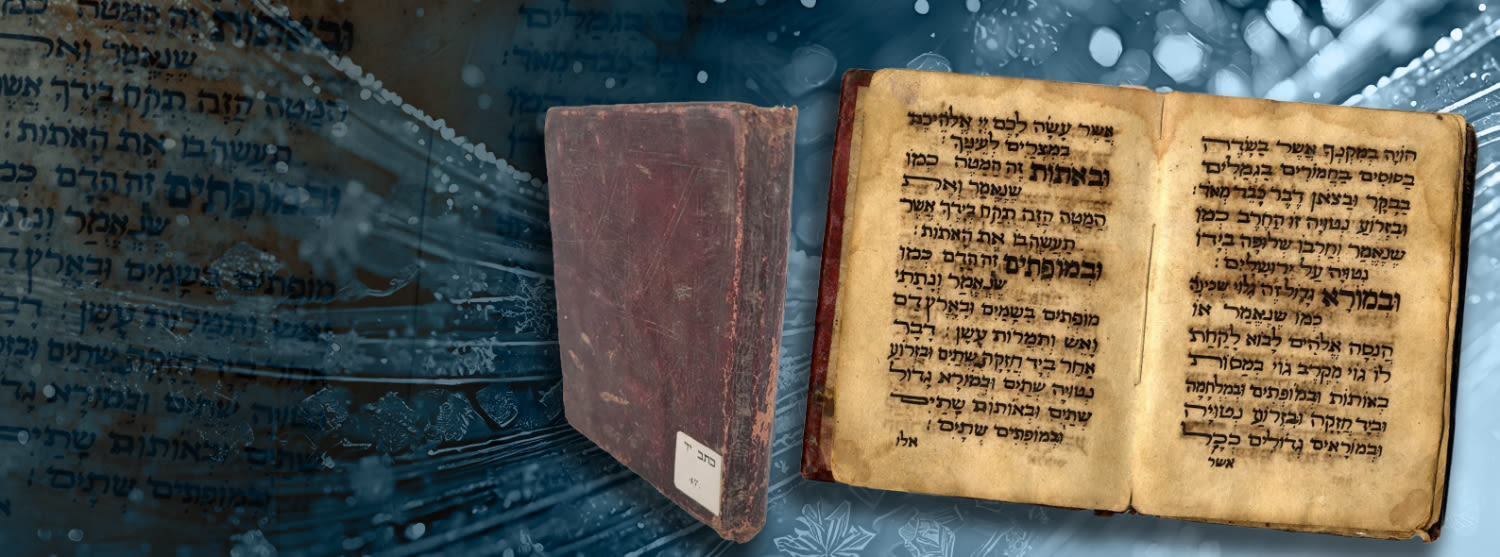
Beautiful and complete manuscript of a Passover Haggadah.
Owner’s inscription on the flyleaf: Mulla Avraham.
The original haggadah text is written in Lashon HaKodesh . The haggadah opens with the simanim of the seder: ” Kaddesh, U’Rechaz, Karpas, Yachatz …”
Each siman is written in its place in bold letters with a short explanation in Judeo-Persian.
Song at the end of the haggadah: “Yisrael mi Kamocha.”
[30] leaf. 15 cm.
Fine condition. Aging and usage stains. Light tears without lack. Original leather binding, loose.
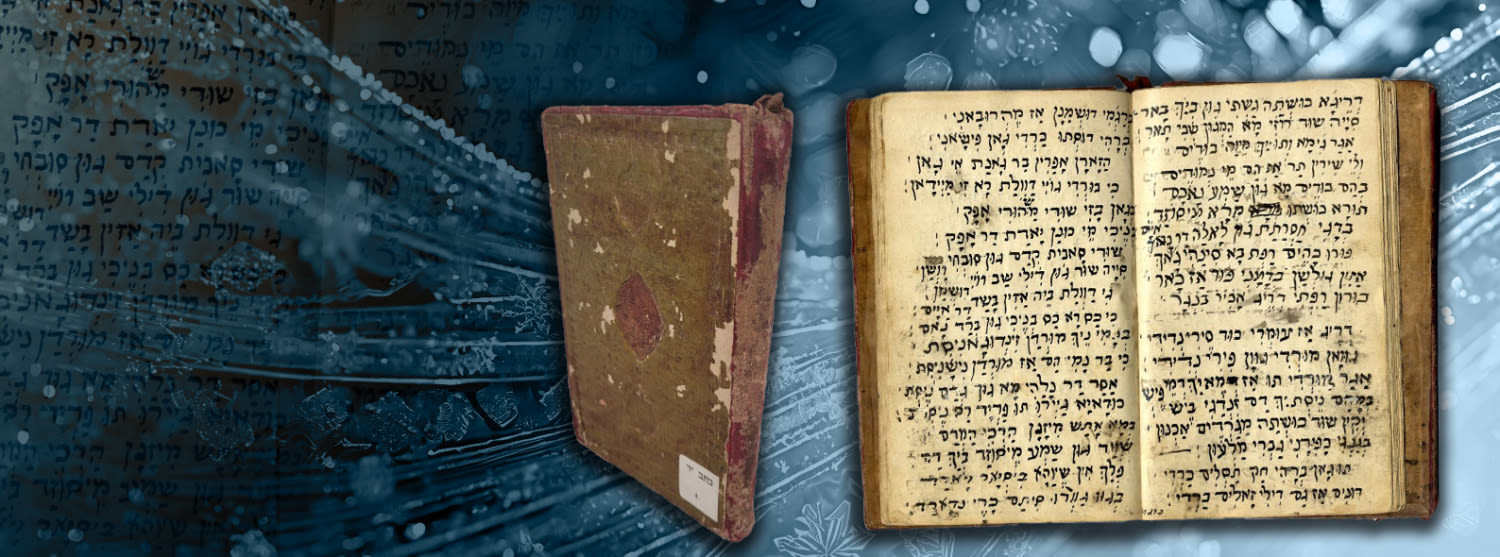
Complete handwritten collection of songs and midrashim in Bukharian.
Colophon at the end with the date, the year 1872.
Titles in large letters.
[66] leaf paper. 18 cm.
Moderate-fine condition. Slight tears. Characteristic original leather binding with minimal chafing.
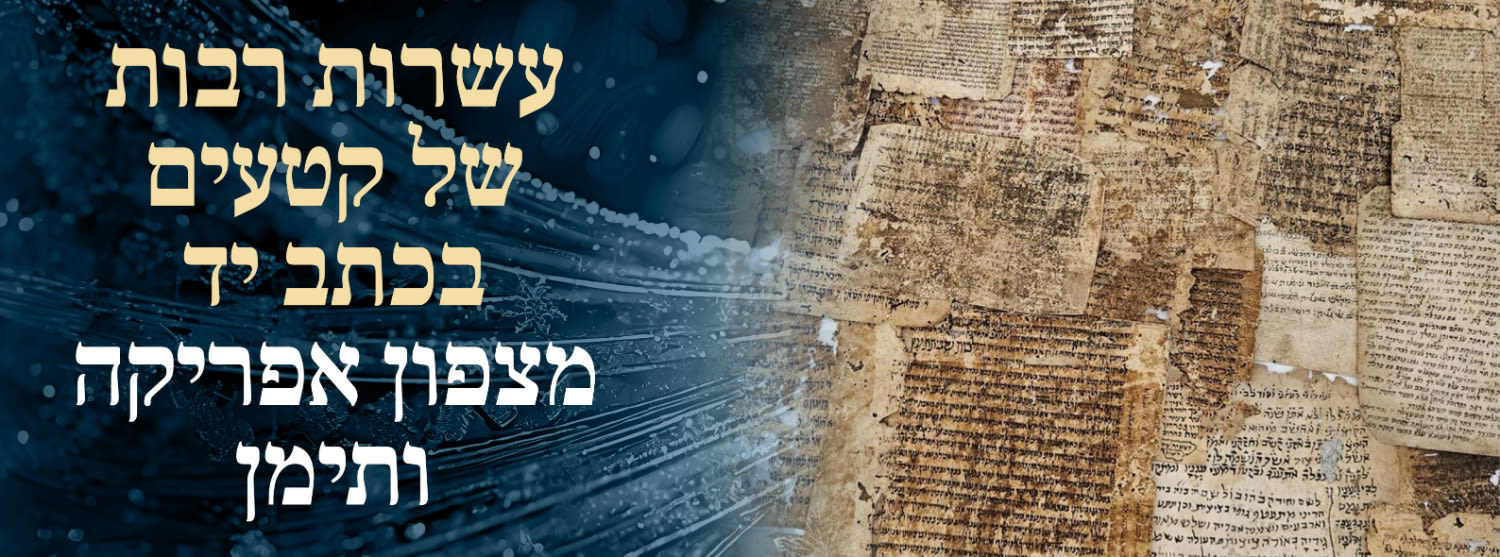
Many dozens of handwritten passages. North Africa and Yemen.
Commentary on the Torah, midrashim , hymns, passages from the Torah, haftarot and Midrash HaGadol, pessukim , prayers, derashot and more.
Various sizes.
Overall poor-moderate condition.
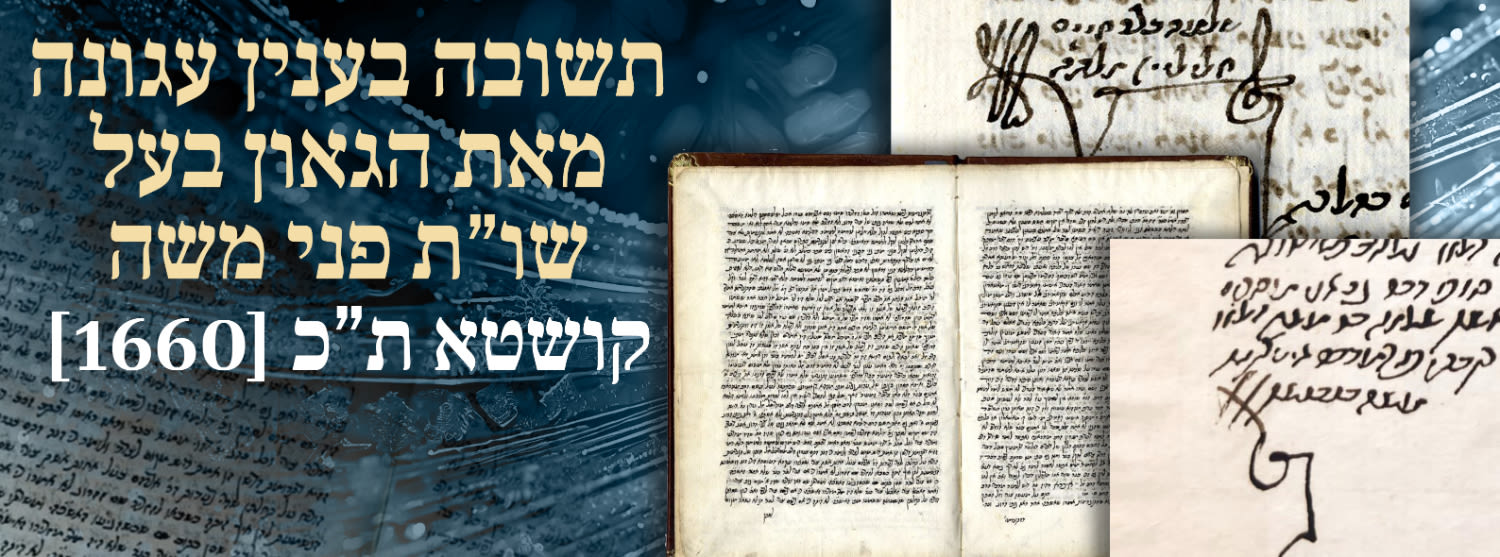
Approbation for a responsum about an agunah handwritten and signed by the gaon Rabbi Moshe Benveniste, author of Shu”t Pnei Moshe . Constantinople, 1660.
Lengthy halachic responsum about an agunah by Rabbi Shlomo Chalilio, a rabbi in Gallipoli, Turkey, with the approbation of the gaon Rabbi Moshe Benveniste, a leading chacham of Constantinople and one of the leading Acharonim among the Sephardic sages, known for his responsa work, Pnei Moshe .
Refer to the Hebrew catalog text for a brief biography of the gaon Rabbi Moshe Benveniste, author of Shu”t Pnei Moshe .
The responsum and the approbation from the author of Pnei Moshe were printed in his sefer , Amar Sh lomo , Even HaEzer section 2.
[11] written pages. 21 cm. The responsum from the author of Pnei Shlomo is written on the last two leaves.
Very fine condition, preserved in a new leather binding.
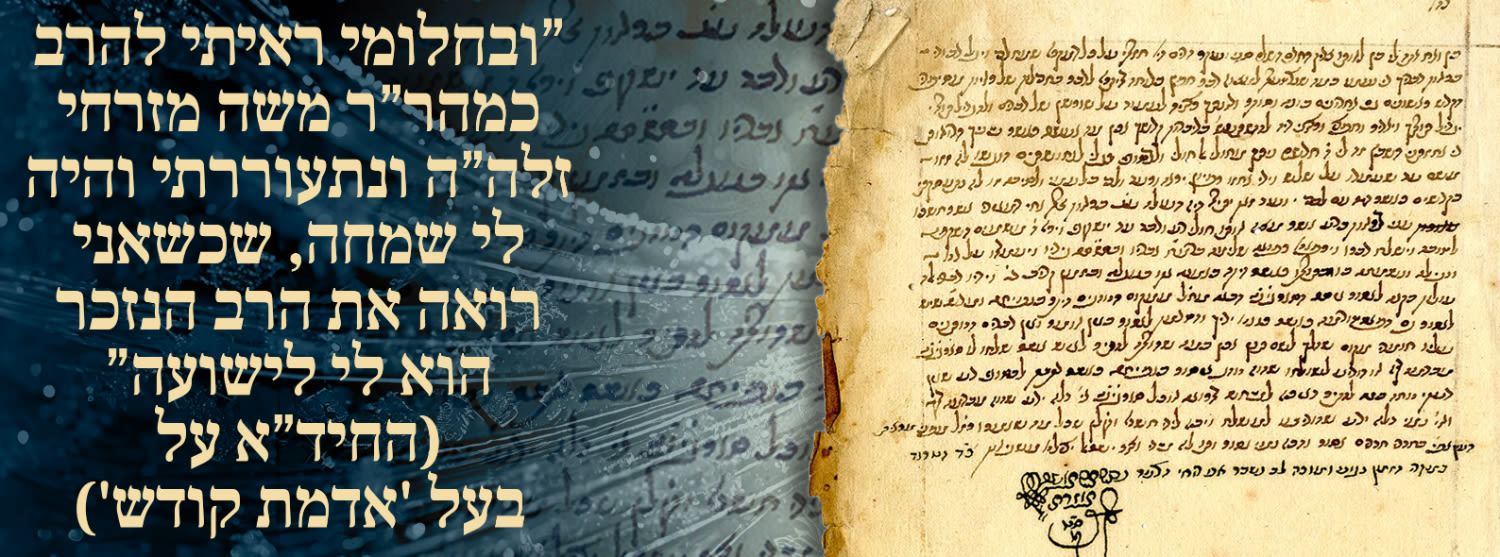
“In my dream, I saw Rabbi Moshe Mizrachi zllh”h. I woke up and was happy. When I see said rabbi, it’s a salvation for me” (the Chid”a, regarding the author of Admat Kodesh )
Beautiful halachic responsum regarding the kashrut status of sausages, by the Rishon LeTziyon Rabbi Chaim Nissim Moshe Mizrachi, author of Admat Kodesh – one of the leading sages among Sephardic Acharonim. Oriental semi-cursive script. Pictorial signature. [Jerusalem, 18th century.]
The responsum discusses sargija [a type of sausage] which came from abroad, from a place where they allowed inflating [the lung]. The first part of the letter is the Rishon LeTziyon’s apology for not answering at length due to his illness and his weakness. “I experienced a stroke four months ago; I am going from one illness to another.” As such, he also did not write the responsum by hand. However, the final line in the letter and the signature are in his penmanship: “Such are the words of one suffering from the travails of time. Plagued and beaten, used up and brokenhearted, the small one Nissim Chaim Moshe Mizrachi S”T.”
Refer to the Hebrew catalog text for a brief biography of the Rishon LeTziyon Rabbi Chaim Nissim Moshe Mizrachi .
[1] leaf, 15×20 cm. High-quality Italian paper.
Fine condition. Minimal aging stains and worming perforations. Tears in the margins without damage or lack in the text.
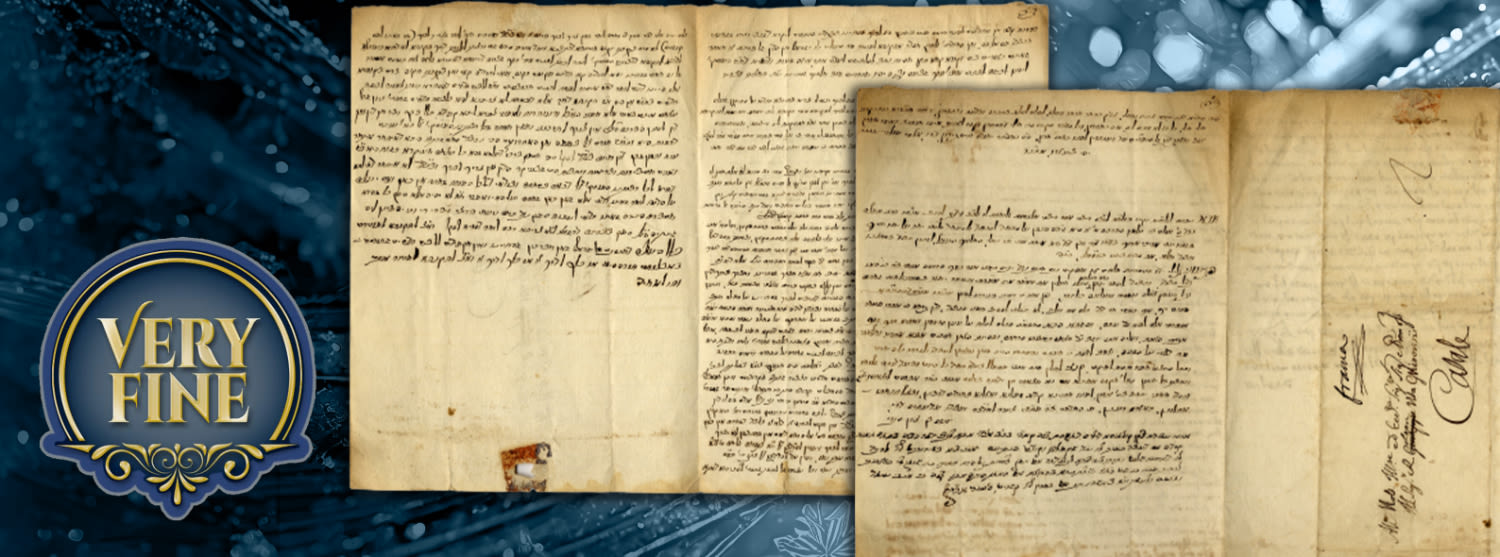
Beautiful and complete letter of responsum spanning three pages, in beautiful Italian script, handwritten and signed by the gaon Rabbi Yehoshua Ben Tziyon Segri, av beit din of Casali. This letter, rare in its completeness, includes the letter with the inquiry, signed; the letter with the responsum, signed; a signed approbation for the responsum; and in-depth pilpul . Casali, c. 18th century.
The letter is addressed to the gaon Rabbi Yehudah Chaim Giron (for more about him, refer to Shu”t Zera Emet Yoreh Deah, siman 32, where there is a responsum from him). This responsum here deals with the shehecheyanu blessing on clothing made for mourners. In rare form, the responsum includes a letter of approbation for its content from one of the leaders of that same generation, who signs with his initials, ‘the youth Aki”m .’
Refer to the Hebrew catalog text for a brief biography of Rabbi Yehoshua Ben Tziyon Segri , av beit din of Casali .
[1] sheet of paper divided into [3] written pages, 24×17 cm each. Thick, high-quality paper. Beautiful Judeo-Italian script. Noted in Italian on this letter is the fact that it was sent from Casali to Parma.
Fine-very fine condition. Fold marks. Aging stains. The letter is folded into an iggeret . Tear marks in the seal, without damage to the text.
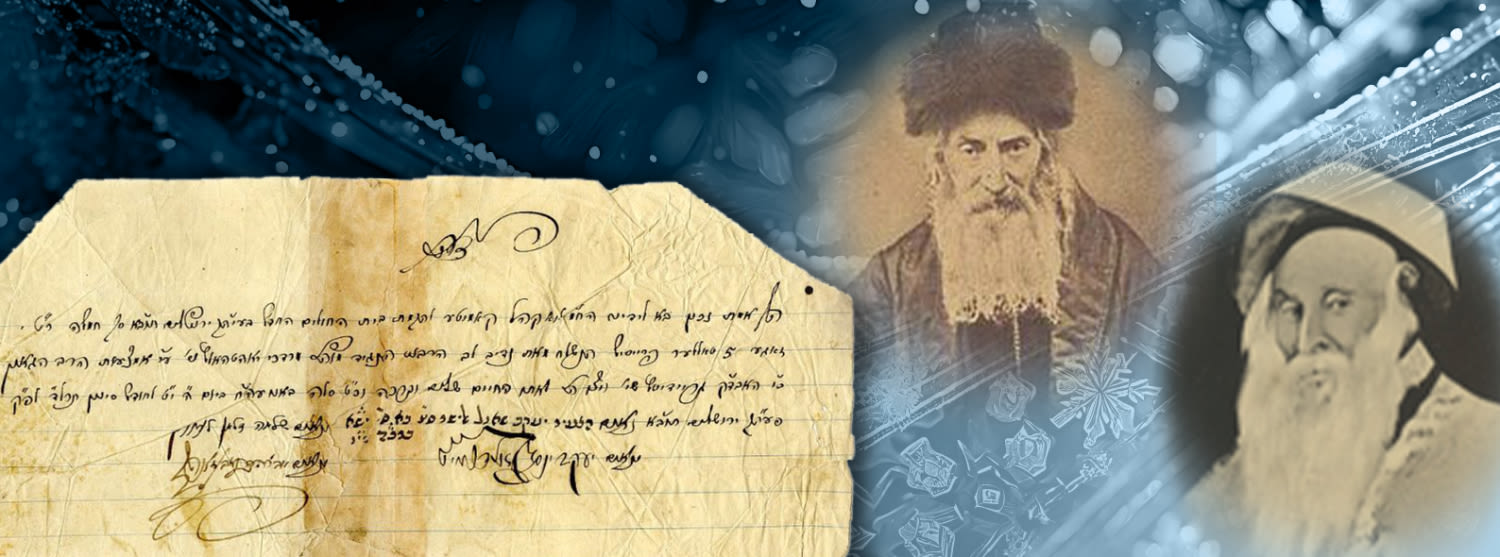
Document signed by Rabbi Ya’akov Shaul Elyashar, author of Yis”a Berachah , confirming receipt of funds to establish a hospital in Jerusalem, through Rabbi Eliyahu Guttmacher of Gröditz. Jerusalem, 1874.
This document constitutes a receipt for funds given to establish the Misgav Ladach hospital in Jerusalem, via Rabbi Eliyahu Guttmacher of Gröditz, signed by Rabbi Ya’akov Shaul Elyashar. With additional signatures from R’ Shlomo Zalman Levine, R’ Ya’akov Yosef Goldschmidt and R’ Avraham Robinson.
Refer to the Hebrew catalog text for brief biographies of Rabbi Ya’akov Shaul Elyashar and Rabbi Eliyahu Guttmacher .
[1] leaf paper. 20×9 cm.
Moderate condition. Restored tear. Creases.
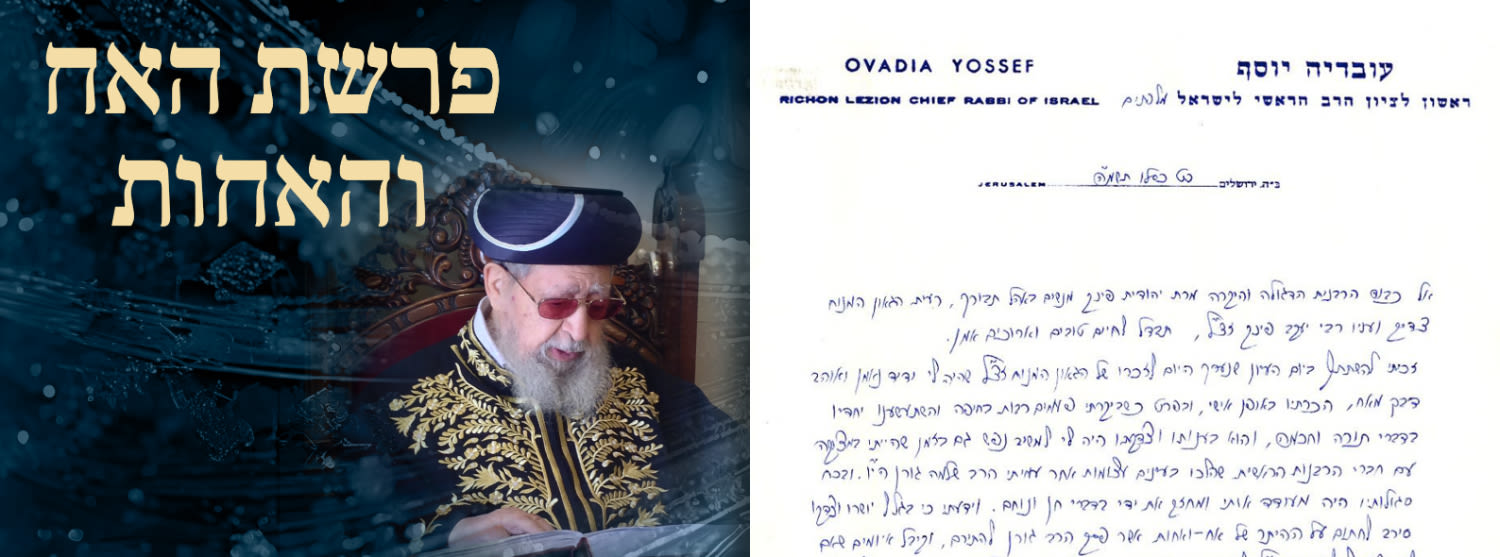
“When I was in trouble with members of the chief rabbinate who followed my colleague, Rabbi Shlomo Goren, with closed eyes”
Letter discussing the affair of “the brother and the sister” [when Rabbi Goren permitted a brother and a sister who were mamzerim , against the opinion of leading rabbis]. This was one of the greatest rabbinic controversies in the State of Israel. Rabbi Ovadia Yosef writes in his beautiful penmanship about his feelings regarding the affair of ‘the brother and the sister’ and the permission Rabbi Goren gave them to marry. Jerusalem, Kislev, 1984.
The letter was sent to the widow of Rabbi Ya’akov Fink, former av beit din of Haifah . Rabbi Ovadia Yosef writes about his feelings “when I was in trouble with members of the chief rabbinate who followed my colleague, Rabbi Shlomo Goren, with closed eyes.” He writes that Rabbi Fink supported him gracefully and pleasantly in the matter. Rabbi Ovadia Yosef reveals in this letter that because Rabbi Fink refused to sign the hetter , he received threats that as a result of his refusal, he would not be selected as chief rabbi of Haifah. Despite this, he persevered and fulfilled what is written, “You shall not be afraid of any man.”
The entire letter is in Rabbi Ovadia Yosef’s beautiful penmanship and his signature. Written on Rabbi Ovadia’s official stationery from his role as Rishon LeTziyon and chief rabbi of Israel. Alongside the words “Chief Rabbi of Israel’ Rabbi Ovadia added “previous.”
Refer to the Hebrew catalog text for a brief biography of the gaon Rabbi Ovadia Yosef and a short discussion of the ruling on the brother and the sister .
[1] leaf, approximately 24 cm.
Very fine condition.